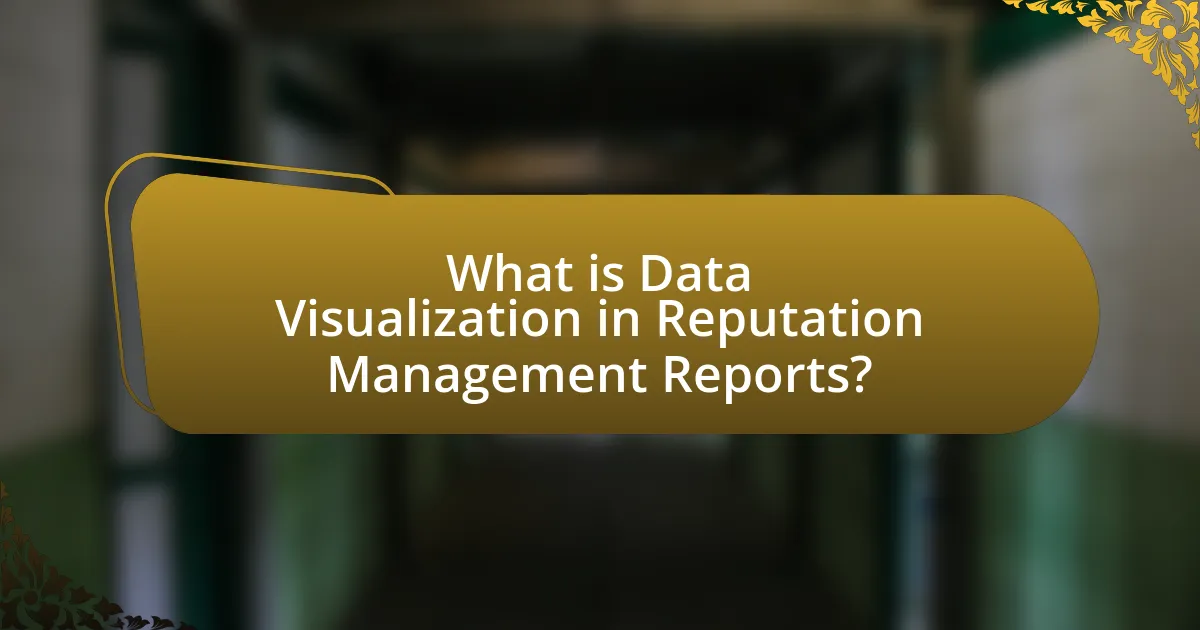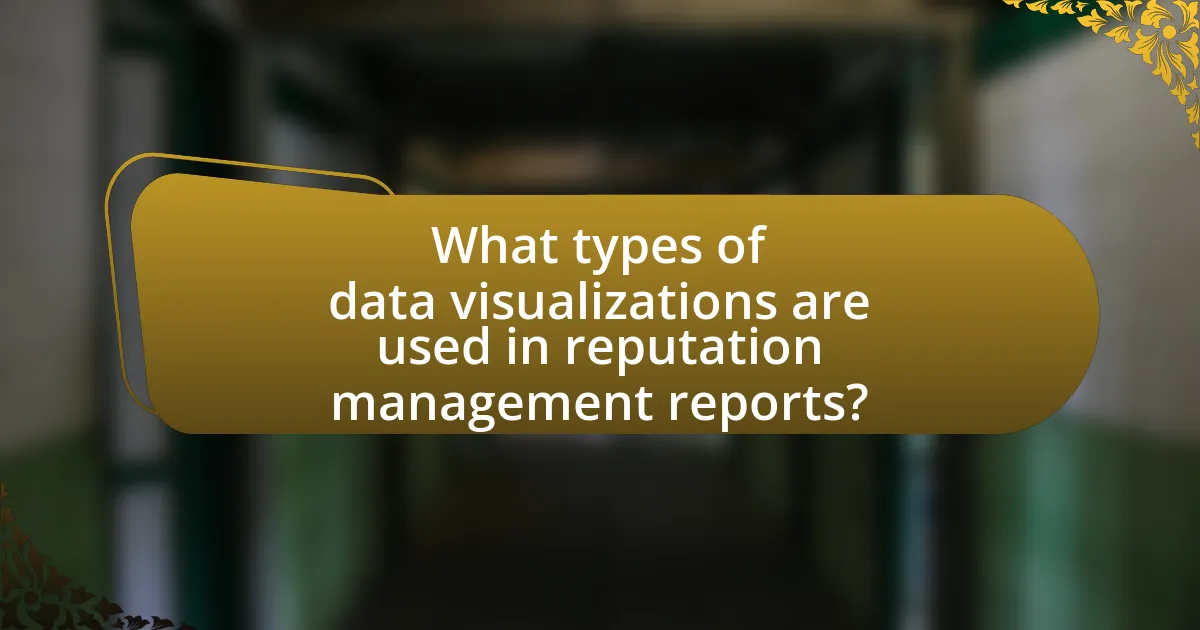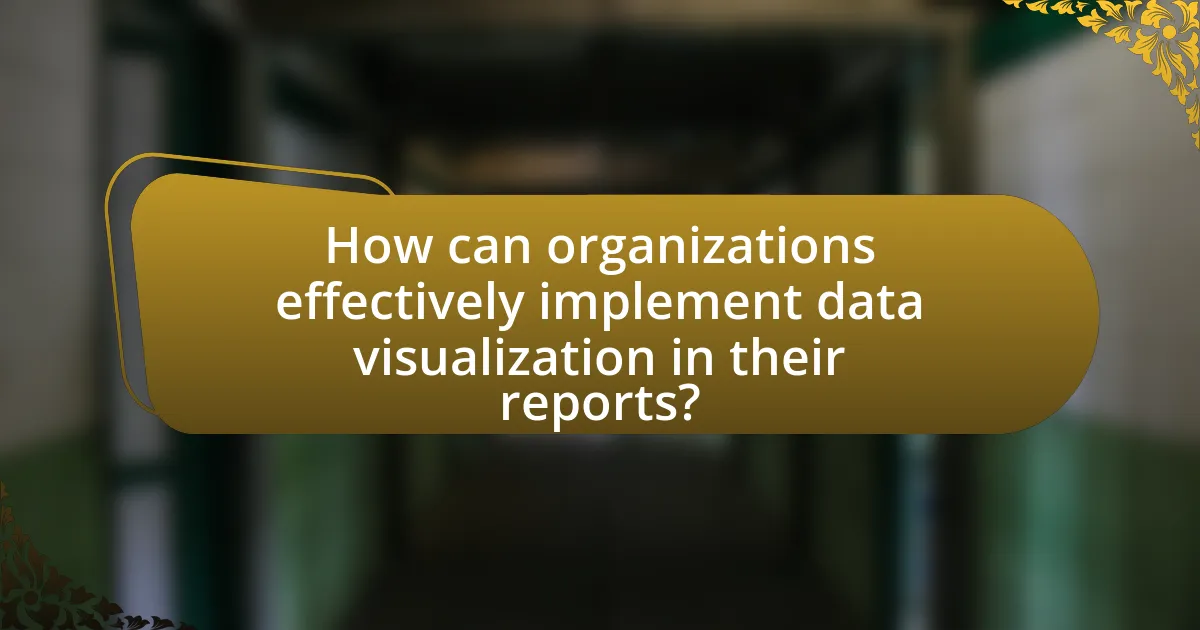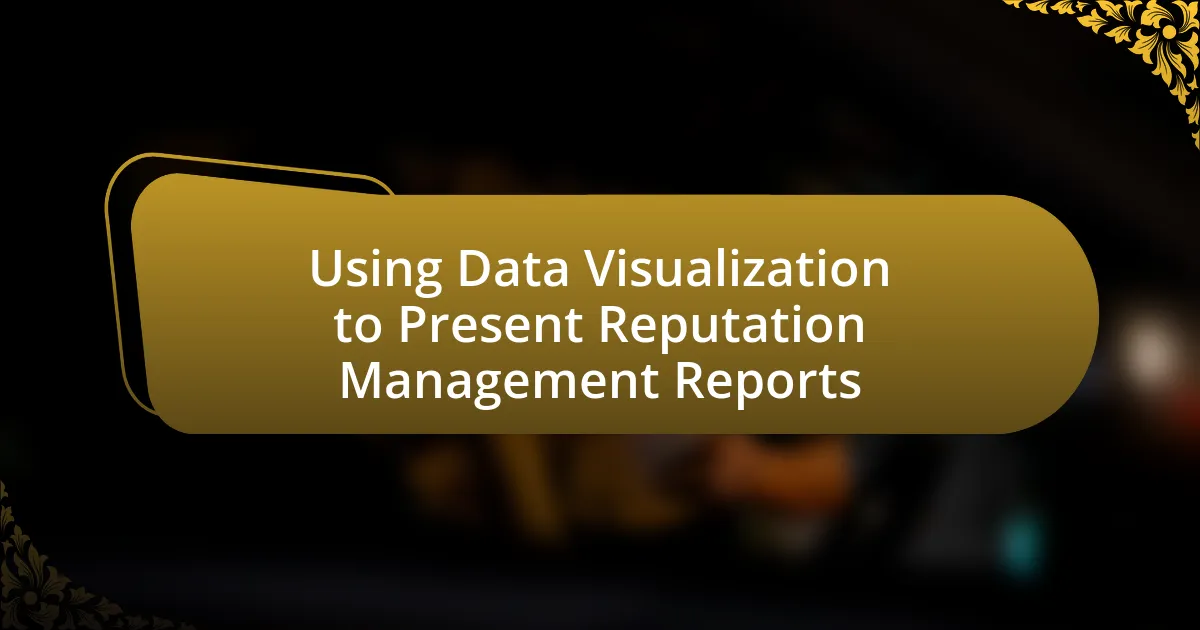Data visualization in reputation management reports involves the graphical representation of data related to a brand’s reputation, utilizing charts, graphs, and dashboards to simplify complex information. This approach enhances clarity and facilitates quick insights, allowing stakeholders to identify trends and make informed decisions. Key elements of effective data visualization include clarity, accuracy, and engagement, while various techniques such as bar charts, line graphs, and infographics are employed to present data effectively. The article also addresses the importance of choosing appropriate visualization tools and best practices to ensure accurate and impactful data representation in reputation management.

What is Data Visualization in Reputation Management Reports?
Data visualization in reputation management reports refers to the graphical representation of data related to a brand’s reputation, enabling stakeholders to quickly comprehend complex information. This method utilizes charts, graphs, and dashboards to illustrate metrics such as sentiment analysis, customer feedback, and social media mentions, making it easier to identify trends and insights. For instance, a report may display a line graph showing changes in customer sentiment over time, which can help businesses understand the impact of their reputation management strategies. By transforming raw data into visual formats, organizations can enhance decision-making processes and effectively communicate their reputation status to stakeholders.
How does data visualization enhance reputation management reporting?
Data visualization enhances reputation management reporting by transforming complex data into easily interpretable visual formats, such as charts and graphs. This clarity allows stakeholders to quickly identify trends, patterns, and anomalies in reputation metrics, facilitating informed decision-making. For instance, a study by the Nielsen Norman Group found that visual information is processed 60,000 times faster than text, underscoring the efficiency of visual data representation in conveying critical insights. By utilizing data visualization, organizations can effectively communicate their reputation status and performance over time, leading to more strategic reputation management efforts.
What are the key elements of effective data visualization?
The key elements of effective data visualization include clarity, accuracy, and engagement. Clarity ensures that the visual representation communicates the intended message without confusion, allowing viewers to quickly grasp the information presented. Accuracy is crucial as it guarantees that the data is represented truthfully, preventing misinterpretation and maintaining credibility. Engagement involves using design elements such as color, layout, and interactivity to capture the audience’s attention and encourage exploration of the data. These elements collectively enhance the effectiveness of data visualization in conveying complex information succinctly and understandably.
How do visual elements influence data interpretation?
Visual elements significantly influence data interpretation by enhancing comprehension and retention of information. Effective use of colors, shapes, and layouts can guide viewers’ attention, making key insights more accessible. For instance, studies show that color-coded data can improve recall by up to 78%, as it helps differentiate categories and highlights trends. Additionally, visual elements like charts and graphs can simplify complex datasets, allowing for quicker analysis and decision-making. Research published in the journal “Cognitive Science” by researchers from the University of California demonstrated that visual representations lead to better understanding and faster processing of information compared to text-based data alone.
Why is data visualization important for reputation management?
Data visualization is important for reputation management because it enables organizations to effectively communicate complex data in a clear and accessible manner. By transforming raw data into visual formats such as charts and graphs, stakeholders can quickly identify trends, patterns, and anomalies that may impact reputation. For instance, a study by the Data Visualization Society found that visual data representation can improve comprehension by up to 80%, allowing companies to make informed decisions based on real-time insights. This clarity helps organizations proactively address potential reputation issues and enhances their ability to engage with audiences effectively.
What insights can be gained through visual representation of data?
Visual representation of data provides insights by simplifying complex information, making patterns and trends easily identifiable. For instance, charts and graphs can reveal correlations between variables, such as customer sentiment and brand reputation, which might not be apparent in raw data. Research shows that visual data can enhance comprehension by up to 400%, as indicated by studies from the University of Minnesota, demonstrating that people process visual information faster than text. This efficiency allows stakeholders to make informed decisions quickly, improving response strategies in reputation management.
How does data visualization improve stakeholder communication?
Data visualization improves stakeholder communication by transforming complex data into easily interpretable visual formats, such as charts and graphs. This simplification allows stakeholders to quickly grasp key insights and trends, facilitating informed decision-making. For instance, a study by the Data Visualization Society found that visual data representation can increase information retention by up to 65%, compared to text-based data alone. By presenting data visually, stakeholders can engage more effectively, leading to enhanced collaboration and alignment on strategic objectives.

What types of data visualizations are used in reputation management reports?
Reputation management reports utilize various types of data visualizations, including bar charts, line graphs, pie charts, heat maps, and word clouds. Bar charts effectively compare different metrics, such as sentiment scores across various platforms, while line graphs illustrate trends over time, such as changes in brand perception. Pie charts provide a clear representation of market share or sentiment distribution, and heat maps visualize data density, such as customer feedback across different regions. Word clouds highlight frequently mentioned terms in reviews or social media, offering insights into public perception. These visualizations enhance the clarity and impact of the data presented in reputation management reports.
What are the most common data visualization techniques?
The most common data visualization techniques include bar charts, line graphs, pie charts, scatter plots, and heat maps. Bar charts effectively compare quantities across different categories, while line graphs illustrate trends over time. Pie charts represent proportions of a whole, making them useful for showing percentage distributions. Scatter plots display relationships between two variables, helping to identify correlations. Heat maps visualize data density or intensity across a two-dimensional space, often used to highlight patterns in large datasets. These techniques are widely utilized in various fields, including business analytics and reputation management, to convey complex information clearly and effectively.
How do bar charts and pie charts differ in presenting reputation data?
Bar charts and pie charts differ significantly in presenting reputation data by their structural representation and the type of insights they provide. Bar charts display data using rectangular bars, allowing for easy comparison of different categories, which is particularly useful for showing changes in reputation over time or across various entities. In contrast, pie charts represent data as slices of a whole, making them effective for illustrating the proportion of each category relative to the total, but they can obscure precise comparisons between categories. Research indicates that bar charts are generally preferred for comparative analysis due to their clarity and ease of interpretation, while pie charts are more suited for displaying percentage distributions.
When should heat maps be used in reputation management?
Heat maps should be used in reputation management when analyzing customer sentiment and engagement patterns. They provide a visual representation of data, allowing organizations to quickly identify areas of concern or strength in their reputation. For instance, a heat map can highlight regions where negative reviews are concentrated, enabling targeted responses. Additionally, heat maps can illustrate the effectiveness of reputation management strategies over time, showing shifts in public perception. This visual tool enhances decision-making by presenting complex data in an easily interpretable format, which is crucial for timely and effective reputation management.
How can infographics enhance reputation management reports?
Infographics can enhance reputation management reports by visually summarizing complex data, making it easier for stakeholders to understand key insights. By presenting information in a clear and engaging format, infographics can highlight trends, comparisons, and critical metrics that are essential for assessing reputation. Research indicates that visual information is processed 60,000 times faster than text, which underscores the effectiveness of infographics in conveying important messages quickly. Additionally, studies show that reports incorporating visuals are 43% more persuasive, thereby improving the impact of reputation management efforts.
What are the benefits of using infographics for data presentation?
Infographics enhance data presentation by simplifying complex information into visually engaging formats. They facilitate quicker comprehension, as studies show that visuals are processed 60,000 times faster than text. Additionally, infographics improve retention rates; research indicates that people remember 80% of what they see and do compared to only 20% of what they read. This makes infographics particularly effective in conveying reputation management data, allowing stakeholders to grasp key insights rapidly and make informed decisions.
How can storytelling be integrated into infographics?
Storytelling can be integrated into infographics by structuring the visual narrative to guide the audience through a cohesive and engaging flow of information. This involves using a clear beginning, middle, and end, where the beginning introduces the main theme or problem, the middle presents data and insights that support the narrative, and the end offers conclusions or calls to action. For instance, a reputation management report can utilize storytelling by highlighting a brand’s journey through data points that illustrate changes in public perception over time, supported by visuals such as graphs and timelines. This method not only makes the data more relatable but also enhances retention and understanding, as studies show that narratives can improve information recall by up to 65%.

How can organizations effectively implement data visualization in their reports?
Organizations can effectively implement data visualization in their reports by utilizing clear and relevant visual formats that enhance data comprehension. This involves selecting appropriate chart types, such as bar graphs for comparisons or line charts for trends, to accurately represent the data being analyzed. Additionally, organizations should ensure that visualizations are designed with simplicity in mind, avoiding clutter and focusing on key insights that align with the report’s objectives. Research indicates that effective data visualization can improve decision-making by up to 28% (Heer & Bostock, 2010, “Declarative Language for Statistical Graphics”). By integrating these practices, organizations can create impactful reports that facilitate better understanding and engagement with the data presented.
What tools are available for creating data visualizations?
Tools available for creating data visualizations include Tableau, Microsoft Power BI, Google Data Studio, and D3.js. Tableau is widely recognized for its user-friendly interface and powerful analytics capabilities, making it suitable for both beginners and advanced users. Microsoft Power BI integrates seamlessly with other Microsoft products and offers robust data modeling features. Google Data Studio provides a free, web-based platform that allows for easy sharing and collaboration on reports. D3.js is a JavaScript library that enables developers to create highly customizable and interactive visualizations for web applications. These tools are validated by their widespread use in industries for effective data representation and analysis.
How do different software options compare in terms of features?
Different software options for data visualization in reputation management reports vary significantly in features. For instance, Tableau offers advanced analytics and interactive dashboards, while Microsoft Power BI provides seamless integration with other Microsoft products and user-friendly interfaces. Google Data Studio excels in real-time collaboration and sharing capabilities, making it ideal for teams. Additionally, software like Looker focuses on data exploration and business intelligence, allowing for in-depth analysis. Each software’s unique features cater to different user needs, such as ease of use, integration capabilities, and analytical depth, which are crucial for effective reputation management reporting.
What factors should be considered when choosing a data visualization tool?
When choosing a data visualization tool, key factors include ease of use, compatibility with data sources, customization options, and cost. Ease of use ensures that team members can quickly learn and effectively utilize the tool, which is crucial for timely reputation management reporting. Compatibility with various data sources allows for seamless integration of data, enhancing the tool’s utility. Customization options enable users to tailor visualizations to specific audience needs, improving communication of insights. Cost is also a significant factor, as it impacts budget allocation for reputation management initiatives. According to a survey by Gartner, 70% of organizations prioritize ease of use and integration capabilities when selecting data visualization tools, underscoring the importance of these factors in decision-making.
What best practices should be followed for effective data visualization?
Effective data visualization requires clarity, simplicity, and relevance. Clarity ensures that the audience can easily interpret the data presented, while simplicity avoids overwhelming viewers with unnecessary details. Relevance focuses on presenting only the data that supports the key message or insight. For instance, using appropriate chart types, such as bar charts for comparisons and line graphs for trends, enhances understanding. Additionally, employing consistent color schemes and labeling axes clearly contributes to a more effective visual representation. Research indicates that visuals can improve information retention by up to 65%, highlighting the importance of these best practices in enhancing communication and comprehension in reputation management reports.
How can clarity and simplicity be achieved in visual reports?
Clarity and simplicity in visual reports can be achieved by using clear design principles, such as limiting the amount of information presented, utilizing consistent color schemes, and employing straightforward charts and graphs. Research indicates that visualizations that adhere to these principles enhance comprehension and retention of information. For instance, a study by Few (2012) emphasizes that reducing clutter and focusing on key data points significantly improves viewer understanding. Additionally, using labels and legends effectively can guide the audience through the report, ensuring that the message is communicated without ambiguity.
What role does color play in data visualization effectiveness?
Color plays a crucial role in data visualization effectiveness by enhancing comprehension and retention of information. Effective use of color can differentiate data points, highlight trends, and convey meaning, making complex data more accessible. Research indicates that color can improve information recall by up to 78%, as it aids in categorization and prioritization of data. For instance, using contrasting colors can help viewers quickly identify significant changes or patterns in reputation management metrics, thereby facilitating informed decision-making.
What common challenges do organizations face in data visualization?
Organizations commonly face challenges in data visualization such as data quality issues, complexity in data interpretation, and lack of user engagement. Data quality issues arise when the data is inaccurate, incomplete, or outdated, leading to misleading visualizations. Complexity in data interpretation occurs when visualizations are overly complicated or not intuitive, making it difficult for stakeholders to derive actionable insights. Lack of user engagement is often a result of poorly designed visuals that do not resonate with the audience, resulting in low adoption rates of the visualized data. These challenges can hinder effective communication and decision-making within organizations.
How can data overload be avoided in visual reports?
Data overload in visual reports can be avoided by prioritizing key metrics and simplifying visual elements. Focusing on essential data points ensures that the audience can quickly grasp the most important information without being overwhelmed. Research indicates that using fewer colors, limiting the number of charts, and employing clear labels can enhance comprehension and retention. For instance, a study by Few (2012) emphasizes that effective data visualization should present only the necessary information to support decision-making, thereby reducing cognitive load on the viewer.
What strategies can be employed to ensure accurate data representation?
To ensure accurate data representation, employing strategies such as standardization of data formats, validation of data sources, and the use of appropriate visualization techniques is essential. Standardization ensures consistency across datasets, which minimizes discrepancies and enhances comparability. Validation of data sources involves verifying the credibility and reliability of the information, which is crucial for maintaining data integrity. Additionally, using appropriate visualization techniques, such as selecting the right chart types and ensuring clear labeling, helps convey the data accurately and effectively. These strategies collectively enhance the clarity and reliability of data representation in reputation management reports.
What are the key takeaways for using data visualization in reputation management reports?
The key takeaways for using data visualization in reputation management reports include enhancing clarity, facilitating quick insights, and improving stakeholder engagement. Data visualization transforms complex data sets into easily interpretable graphics, allowing stakeholders to grasp trends and patterns rapidly. For instance, a study by the Nielsen Norman Group found that visual information is processed 60,000 times faster than text, underscoring the efficiency of visual formats in conveying reputation metrics. Additionally, effective visualizations can highlight critical areas of concern, enabling proactive management of reputation issues. By employing charts, graphs, and infographics, organizations can present data in a compelling manner that fosters better understanding and decision-making among stakeholders.

Leave a Reply